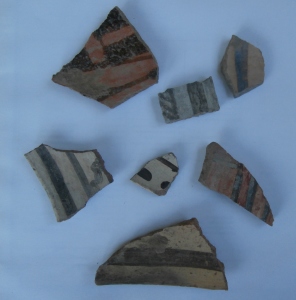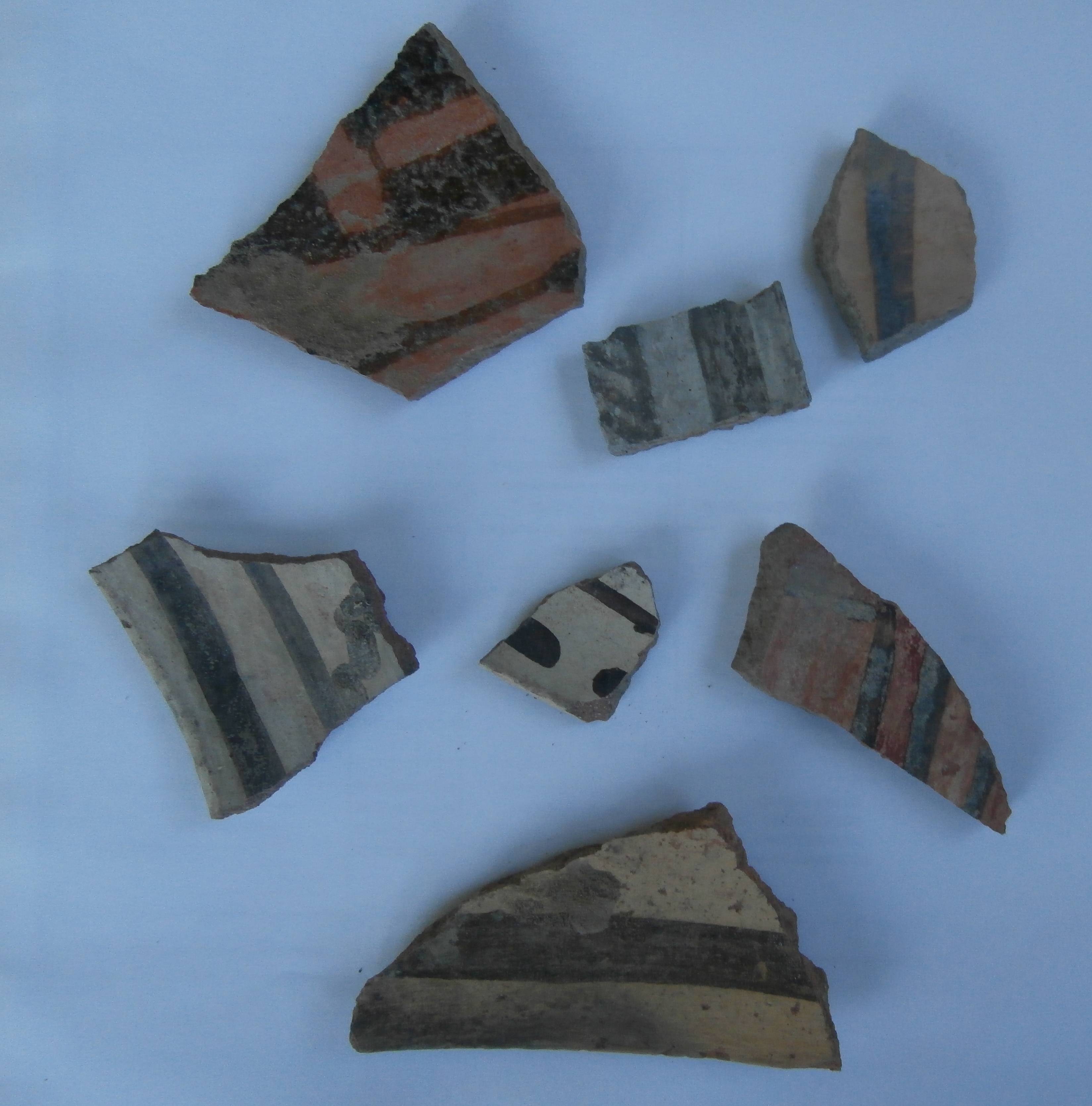
Mr. Fenn, I have a question regarding the two pottery sherds I received from Jenny (for entering the Easter Contest).
The clay in one is gray with only black color used for the design. The other sherd is light colored clay with burnt umber, black and cream color for the design. The gray sherd on its broken side shows many impurities that could cause breakage, while the lighter colored sherd has a more refined composition and is thicker.
My question is, “Did the clay for one or both come from San Lazaro or was the clay brought in from another site? ~ thanks BW
Well, let me answer with what you gave me to work with. The gray colored clay may be from a biscuit ware bowl. The clay comes from near Abiquiu. The black paint is made from Rocky Mountain Bee Weed, which grows all over the southwest. The color is brown, but turns black when fired.
The “impurities” are not that at all, they are temper, which keeps many of the pots from breaking during the firing process. The temper may be ground-up pot sherds, or sand.
The umber colored designs on the other sherd are made from galena, which is lead ore. It is mined about 20 miles south of San Lazaro. The ore is ground up and mixed with water, and heated until it gets a thick viscosity, then it is painted on. Both the mineral and vegetal paints become permanent when the vessel is fired. Hope this helps. f


Thanks for asking that question BW, and Forrest for answering! It is great know and learn more about these amazing sherds.
I’m glad you enjoy them BW. I loved collecting with Forrest, and sharing them. They are definitely treasured and in a wonderful home with you!
The time and hands on experience that it takes to have knowledge like that at a whims notice.
Fascinating question and answer.
I am a fan of the TV show “Time Team”; and their pottery expert, Paul Blinkhorn, always blows my mind because he can so casually and accurately identify the smallest shards of pottery.
I hope one day to be able to identify artifacts so easily as Messrs. Blinkhorn and Fenn.
Thank you BW and Forrest and Jenny! I would like Forrest to tell us more about how they made the pottery and explain the terms. Like when he says fired, how hot and for how long?
Mr. Fenn,
Thank you so much for answering my question. I must confess that I dropped one sherd on my tile floor. Expecting the worst, I was afraid to look down. Much to my relief it had not broken, not even a chip. The temper worked! Whew!!!
Jenny, I hope you don’t retract you “good home” statement.
Lol …no, don’t retract it at all. I’m sure you were just testing it….lol
Thank you Jenny and Forrest for providing more information about the paints on the sherds… Always fascinating to think how and who figured out the various uses of things…. Interesting that Galena was also often used in crystal radios in the 30’s…
It’s fun how the learning about the art and utility of a simple mysterious piece of pottery can make you ask much bigger questions.
Interesting question followed by an interesting answer.
I am curious about the use of lead. Have there been anything to indicated instances of lead poisoning among the Native Americans?
I knew I should have entered this contest. 🙁
As always, another, enjoyable, informative Q & A! Thanks Jenny and Forrest!
🙂
Thanks, Jenny and BW and Forrest! I am honored to hold some of those pottery pieces in my hands…along with a beautiful book about San Lazaro Pueblo, as well. I didn’t know any of those details about the pottery and glazes and firing. I have a large chunk of galena under my favorite roses in the front yard. When I was a boy scout we ended a 50-mile (60+?) backpacking trek arriving in Mineral Basin up American Fork Canyon. We cooled off by playing in a frigid stream and pulling out large pieces of pyrite and galena. Did you know that if you put galena in a hot fire that it will pop like firecrackers when it becomes heated? LOL!!! Well, now you know! Also, you must know that hot little pieces of flying lead are the result! So…if you’re looking to relax around the campfire do NOT put chunks of galena in the fire. See how we can all learn from each other? 🙂
I am still enjoying my sherds! From the contest. I have the arrowhead forrest sent and I am going to make a “Power Necklace” with them and try to channel where the warm waters halt. Just kidding, well maybe?
Thank You Forrest and Jenny!
Lou Lee Belle, is my name and finding where warm waters halt is my game. 🙂
Mr. Fenn, thank you for answering that question. It was especially interesting to me to learn about the mineral pigments, and properties of Galena.
Interesting…
As I have g one al one….
. g al
Thought not an individual element on the periodic table…perhaps reference to galena?
Or, an abbreviation for gallon?
I have other thoughts too, just seemed a good bit to throw these two out…
🙂
Fascinating. It would be equally interesting to hear what Forrest knows about the source war paint pigments, their color symbolism, and how they were stored by the nomadic tribes.
I should have added that reading from internet sources doesn’t pack the same punch as speaking with a life-learner & collector like ff.
Thank you for the information, Forrest.
What part of the Rocky Mountain bee weed is used to obtain the color?
Last year was the first time I got to see pottery sherds up close and I was truly amazed. The small pieces I saw were white and found one that had black designs on it. The pieces were thin and didn’t seem quite as thick as those shown in the photo above. While looking at them and the surrounding area my family and I were at, I began to imagine those who made and held this container which lay in pieces on the ground. I still do.
This is a great memory, Pdenver.
My wife won the Easter Egg Decorating Contest…along with the copy of The Secrets of San Lazaro Pueblo…and 3 one-of-a-kind pottery gaming pieces.
I still like to read the book…and hold the pottery pieces on my hand…and ponder all the Secrets they contain.
Thanks AGAIN, Forrest Fenn and Jenny Kile…and Pdenver.